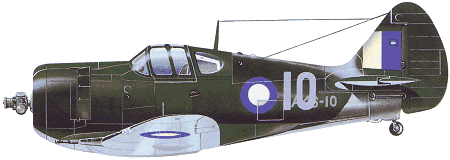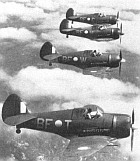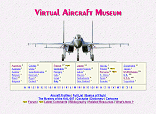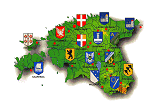Aircraft Profile #178. Commonwealth Boomerang |
|
|
"A la guerre comme a la guerre"; this might have been an appropriate motto for the Commonwealth Boomerang - the only aircraft of Australian design ever to fire its guns in anger - which was born from the sudden needs created by the war's impact on that young nation at a time when the Mother Country was bearing the brunt of the war effort in Europe and when the United States had not yet fully turned their gigantic industrial resources into the arsenal of the free world. In the mid-thirties, when warlike preparations in Germany and Japan began arousing the attention of a few inspired leaders of the free world, Australia had no aircraft industry to speak of. In 1936, however, at the suggestion of the Commonwealth Government, three companies with long experience in overcoming the problems likely to be met in setting up such an industry banded together and formed a syndicate. The purpose of the syndicate was to discover to what extent it would be practical to develop a self-sufficient aircraft industry based on Australian raw materials and industrial facilities. On 17th October, 1936 the syndicate was registered in Victoria as the Commonwealth Aircraft Corporation Pty., Ltd. (C.A.C.). Whilst plans were being prepared for the
With the entry of Japan into the war the Royal Australian Air Force found itself in a most precarious situation. Two of its squadrons and several hundred personnel were operating in England and the Mediterranean theatre whilst closer to home, in Malaya, the R.A.A.F. had two squadrons of Hudson bombers, one squadron of Wirraway general-purpose aircraft and one squadron of obsolescent Buffalo fighters. Aircraft available for operations in the Australian area and the Netherlands East Indies included 53 Hudson bombers, 101 Wirraway general-purpose aircraft, 12 Catalina flying-boats and 9 Seagull flying-boats; a total of 175 first-line aircraft. A further 306 training, transport and communication aircraft were in second-line units. But no fighter was on strength. Except for the production of Bristol Beaufort torpedo-bombers and various training aircraft, Australia had relied on the U.K. and the U.S. to obtain modern aircraft to equip the R.A.A.F. The danger inherent
With this in mind Wing Commander Lawrence Wackett, Manager and Chief Designer of C.A.C, began in the autumn of 1941 to study the possibility of producing in his company's plant a fighter aircraft of Australian design. Many experts were of the opinion that even the manufacturing under licence of complete aircraft was beyond the capacity of Australia but this did not deter Wg. Cdr. Wackett who merely decided to make use of what was already available in Australia. The licence under which the Commonwealth Aircraft Corporation was authorized to manufacture the North American NA-33 contained a clause providing that modifications could, if desired, be made in the design and consequently Wackett decided to design his fighter aircraft around the Wirraway structure. By so doing design and manufacturing On 21st December, 1941 the C.A.C. management gave authority to proceed with the detailed design of the fighter aircraft. At this point it is interesting to note that, although Wg. Cdr. Wackett was probably aware of the development by North American Aviation Inc. of two similar fighter aircraft - the NA-50 for Peru and the NA-68 for Siam - no help was solicited from or given by the designers of the NA-33. The CA-12, as Wackett's design was designated, made use of the wing, tail assembly, undercarriage and centre section of the Wirraway matched to a new forward fuselage housing the larger engine. A new single-seat cockpit with sliding hood was fitted and armament consisted of two 20mm Hispano cannons and four 7.7mm machine guns all mounted in the wing. The proposal was presented to the Commonwealth Government which
When completed in May 1942, the first CA-12 (identification number A46-1) was characterized by a stubby appearance resulting from the installation of a much larger engine in what was essentially a Wirraway structure. The engine was closely cowled with two air scoops, one above for the carburettor and one below for the oil cooler, and drove a de Havilland three-blade propeller without
Flight tests proved that the aircraft had remarkable performances and, in particular, a rate of climb of 900m per minute was demonstrated. However, since the maximum speed of the aircraft was only slightly superior to that of the Buffalo, an aircraft which had not achieved much success against Japanese fighter aircraft in Malaya, there was naturally some hesitation on the part of the Government and comparative trials between the
"At 10,000 feet, the Boomerang is more manoeuvrable than the Kittyhawk and can turn inside it. The Kittyhawk's speed advantage is not sufficient for it to dictate the type of combat and, although it gains more in a dive, the Boomerang's greater manoeuvrability with pull out and superior climb finds it level with the Kittyhawk at the top of the ensuing zoom. The Kittyhawk's only manoeuvre is to dive through a great height and break off the combat; the speed advantage is not sufficient for it to fly away at the same height without becoming vulnerable once combat is joined with the Boomerang. The Airacobra has a greater speed advantage over the Boomerang than has the Kittyhawk but is outmanoeuvred at the same height in concentric attack (turning circles). When first attempted the Airacobra was able to dictate terms of combat to the Boomerang by its superiority in dive and zoom which allowed it to gain the extra
The performances of the CA-12 appeared even more impressive when compared to that of the NA-68, a similar - but unrelated - single-seat fighter aircraft developed by North American Aviation Inc. from their two-seat advanced trainer series. Powered by a 875hp Wright R-1820-77 and armed with two 20 mm cannons and two 7.7mm machine guns, the NA-68 had a maximum speed of only 435km/h at 2650m. Production of the 105 CA-12s (A46-1 to A46-105) under the original contract was completed in June 1943. Several modifications were made to the aircraft either on the assembly line or at operational bases, including strengthening of belly tank locating pins and of the spinner back plates, and were aimed at correcting minor difficulties experienced in the field. Starting with the 36th aircraft (A46-36), night flying identification lights were installed under the wing centre section offset to starboard, and the 94th and subsequent aircraft had a revised electrical starter system. One aircraft, A46-103, was modified to flight test the revised centre section leading edge used on the experimental CA-14 and CA-14A and
THE CA-12 BOOMERANG DESCRIBED Type: Single-seat fighter monoplane. Fuselage: Welded chrome-molybdenum steel tube framework with integrally welded fittings. Plywood rear fuselage side and top fairings fitted over wooden formers and stringers. Monocoque bottom fuselage fairing. Pilot's cockpit over centre of the wing provided with a sliding canopy, 38mm bullet-proof glass windscreen and armour protection. Tubular truss turnover pylon behind the pilot's seat. Wings: Low-wing cantilever monoplane. In five sections consisting of centre-section, two outer sections and two detachable wing-tips. Constant thickness centre-section with leading edge extending forward to form the wheel wells. Outer sections with swept-back leading edge and straight trailing edge and taper in thickness. Single-spar structure with stressed-skin covering. Fabric covered ailerons with aluminium alloy trim tabs. Split trailing edge flap between ailerons and under fuselage. Tail Unit: Cantilever monoplane type. Fixed surfaces metal-covered and movable surfaces fabric-covered. Aluminium trim tabs provided on all movable surfaces. Undercarriage: Hydraulically operated inwardly retractable main undercarriage with the wheel wells forward of the main spar. Non-retractable free-swivelling tail wheel. Armament: Two Hispano Mk. II or C.A.C.-built 20mm cannons with 60 r.p.g. and four 7.7mm Browning Mk. II Power Plant: One C.A.C.-built 1,200hp Pratt & Whitney R-1830 S3C4-G Twin Wasp fourteen-cylinder radial air-cooled engine. Take-off rating: 1,200hp at 2,700 r.p.m. Military rating: 1,200hp at 2,700 r.p.m. and 1500m and 4000m. Maximum rating: 1,100hp at 2,550 r.p.m. and 1890m; 1,000hp at 2,550 r.p.m. and 3800m. Three-blade Hamilton 3T50 constant-speed metal propeller. Oil tank mounted in the engine compartment ahead of the firewall had an oil capacity of 64 litres. Fuel System: One 318-l fuselage self-sealing petrol tank and two 204-l tanks in the wing centre-section. A 318-l plywood drop tank could be carried under the fuselage if required. Total petrol tank capacity: 1044 litres. BOOMERANG VARIANTS When difficulties were encountered in the development of the Commonwealth CA-11 Woomera twin-engined bomber and production of the type appeared doubtful (the production contract for the CA-11 was eventually cancelled in September, 1944), the production contract for the Boomerang was amended to cover 250 machines. Following the manufacturing of the 105 CA-12s covered by
CA-13: Second production batch of 95 aircraft (A46-106 to A46-200). The Twin Wasp S3C4-G was retained but its straight-through exhaust pipe was replaced by a flame-damper exhaust similar to the one used on the Australian Beaufort bombers to reduce glare during night operations. Various minor modifications were incorporated and included the replacement of the fabric covered ailerons by aluminium covered units, the change from metal covered wing-tips to wooden wing-tips, and a revised electrical system incorporating a more powerful generator. Changes in the cockpit included the switch from a light alloy pilot's seat to one made of laminated wood and the fitting of an improved control column grip handle. Mechanical cocking of the guns on the ground replaced the in-flight hydraulic cocking system fitted on the CA-12 as the type had proven prone to gun failures. During their operational life many CA-13's were modified and A46-121 (QE-D) was fitted by ground crews of No. 4 Squadron, R.A.A.F., with a modified belly tank housing two cameras for low-altitude vertical and oblique photography. During the take-off the camera lenses were protected by a piece of cardboard which was removed in flight by means of a string
CA-19: Third and last production batch of 49 aircraft (A46-201 to A46-249). The CA-19 differed from earlier Boomerang versions only in minor internal details. Treaded tyres, first used on some CA-13s, were standardized. Commencing with A46-211, provision was made in the rear fuselage for a Fairchild F24 camera. The last Boomerang built, the CA-19A46-249, was delivered in February, 1945. THE SUPERCHARGED BOOMERANG Even though the performances of the Boomerang had exceeded expectations and were indeed remarkable for a stop-gap fighter designed and built in such a short time, it still remained obvious that the aircraft was somewhat slower than contemporary Japanese fighter aircraft and much slower than the British and American fighter aircraft which reached the Pacific theatre in late 1942 and early 1943. In particular the Boomerang lacked high altitude performances which were mandatory in its planned use as an interceptor fighter.
Tests with the sole prototype CA-14, identification number A46-1001, revealed a marked improvement in performance at altitude but the aircraft suffered considerable buffeting due to the large air intake. The aircraft was then returned to C.A.C. for modification. The air intake for the turbo-supercharger was replaced by a streamlined air duct on the port side between the supercharger and the cleaned-up cowling now incorporating the 18-blade cooling fan previously tested on A46-157. The propeller was changed for a three-blade variable pitch de Havilland unit and the vertical surfaces were replaced with the square fin and rudder which had been tested on A46-103. Delivered to No. 1 A.P.U. in June, 1944, the CA-14A, as the modified prototype was designated, reached a maximum speed of 560km/h at
BOOMERANGS AT WAR On the 10th October 1942, No. 2 Operational Training Unit at Mildura, Victoria, received its first CA-12 and immediately began training Boomerang pilots. Most of these pilots had no previous operational experience and although they had received their training on Wirraway aircraft many ran into troubles when first being acquainted with the Boomerang. The fitting of a much larger engine on what was still basically a Wirraway airframe had resulted in poor forward visibility on the ground and young pilots had difficulty in controlling propeller torque with discriminate use of brakes and rudder. Experiences acquired at No. 2 O.T.U. also dictated the re-positioning of the reflector gun sight to improve pilot vision. But by and large the Boomerang was considered a successful aircraft, except for engine overheating which necessitated flying the aircraft with gills partly open with a resultant reduction in speed. Modification of the engine mounting and fitting of heavier backplates corrected this problem. While in early 1943 the Allies prepared a limited
Since the early months of the war Nos. 4 and 5 Army Cooperation Squadrons, R.A.A.F., had performed valuable service with their Wirraway aircraft and it was logical, when higher performance American and British aircraft became available to equip R.A.A.F. fighter squadrons, that the Boomerang be assigned to these two units as its higher speed and heavier armament gave it a better chance to survive than the Wirraway. No. 4 Army Cooperation Squadron received its first Boomerangs on 15th June 1943 and took them into action during the assault on Nassau Bay, near Salamaua in New Guinea, on 1st July. The pilots were frequently challenged by Allied anti-aircraft gunners because the Boomerang had characteristics of speed and shape different from known Allied aircraft in the South-West Pacific. On 5th July, when returning from a reconnaissance mission, a Boomerang (A46-88) was shot down over Nassau Bay by American gunners whose nerves had been shaken earlier that day by Japanese aircraft. Taking advantage of their
On 14th August 1945 No. 4 Army Cooperation Squadron, then part of the First Tactical Air Force participating in the invasion of Borneo, was instructed to suspend offensive operations against land targets except direct support for Allied ground forces in contact with the enemy. The war was over. Born from the urgency which faced Australia in the tragic hours of December 1941, the Boomerang never had to show its might in the type of operations for which it was conceived; but in its unspectacular role as a ground support aircraft it earned the admiration and gratitude of the troops inching their way through the damp jungles of the South-West Pacific. Rene J. Francillon, 1967. |
 All the World's Rotorcraft
|


















